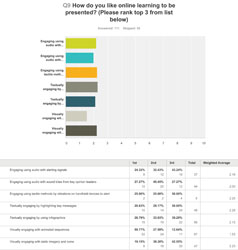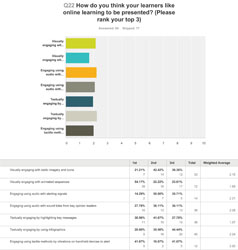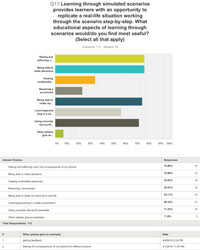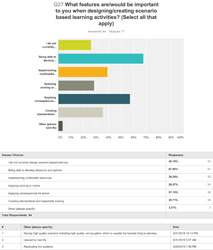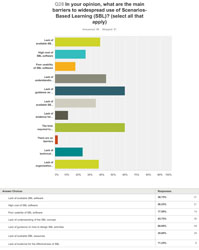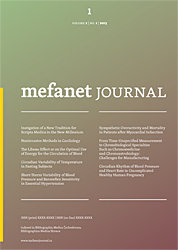
MEFANET Journal 2016; 4(2): 65-70
TUTORIAL
User stories can help you to shape the design of an educational project: experience from WAVES
Daniel Schwarz1*, Sheetal Kavia2
1 Faculty of Medicine, Masaryk University, Brno, Czech Republic
2 E-learning Unit, St George’s, University of London, London, United Kingdom
* Corresponding author: schwarz@iba.muni.cz
Abstract
Article history:
Received 26 January 2017
Accepted 26 January 2017
Available online 31 January 2017
Download PDF
Interactive virtual scenarios and simulations in scenario-based learning are recognised by many teaching and learning communities as effective tools for developing reasoning, and for safe training in workplace competency. The WAVES project takes scenario-based learning ‘out-of-the-box’, to make it more accessible for a wide range of professions. User stories – the common artefacts used in many agile software development techniques – were used in the early stage of the WAVES project to shape future developments of existing software for authoring and playing virtual scenarios. The use of a specific template of a user story together with a gaming activity for sorting of all obtained user stories helped to simplify and accelerate the creation of user requirement specification document.
Keywords
Virtual scenarios; scenario-based learning; user requirements; user stories; software development
Background
The ERASMUS+ funded project entitled Widening Access to Virtual Educational Scenarios (WAVES) combines skill sets of both academic and enterprise partners to make Scenario-Based Learning (SBL) more accessible for a wide range of professions. SBL techniques are widely recognised as a key tool in the educational toolkit, for safe training in competency and decision-making [1].
There are several technical activities in the WAVES project, aiming at shaping upcoming developments of software – already available for authoring and playing virtual scenarios. As in any other projects involving a software development activity, the first step is to determine needs by composing a User Requirements Specification document (URS).
Creation of a URS document is said to be the single most important element in many guidelines, practices or event project management methodologies. For instance, Good Automated Manufacturing Practice (GAMP), which was widely adopted by the pharmaceutical industry, includes a risk-based approach to computerized systems [3]. This approach can be explained by the V-model of the systems engineering process, which contrasts the specifications produced for a system to the testing performed as part of a verification process, see Figure 1.
The recent agile methodologies (see [3] for agile software development) for managing software development processes often shift the focus from writing about URS to talking about the requirements. Agile software development emphasizes frequent deliveries of working software, close customer collaboration and ability to respond quickly to changes. The particular agile methodologies (e.g. SCRUM or KANBAN) deliver set of development artefacts, among them are user stories – written as simple reminders to a conversation with project stakeholders or customers.
In the next sections, we show our approach to the creation and the use of user stories in the early stage of the WAVES project.
Figure 1. The V-model of the Systems Engineering Process. Image extracted from [2]
Figure 2a. Selected results from the on-line survey: Question 9 – How learning like their online learning to be presented
Figure 2b. Selected results from the on-line survey: Question 22 – What educators think learners want their online learning to be presented
Figure 2c. Selected results from the on-line survey: Question 13 – What education aspects of learning with SBL is most useful?
Figure 2d. Selected results from the on-line survey: Question 27 – What educators think are important features when creating SBL?
Figure 2e. Selected results from the on-line survey: Question 28 – What educators think are the main barriers to widespread use of SBL?
Figure 3. Agile card sorting activity during the WAVES project kick-off meeting
WAVES on-line survey
A 44-item on-line survey was developed by the project partners and distributed via email, social media, and websites in April 2016. In total, 161 participants from 21 different countries responded to the questions. There were participants from all main target groups of the project - learners, educators, and technologists. The survey covered questions on general online learning resources, Scenario-Based Learning and Massive Open Online Courses. Selected results from the survey are summarized in Figure 2. Several key-messages identified in the obtained data are summarized in Table 1.
Table 1. Key-messages for End-User Specifications – identified in the dataset gathered during the on line survey
|
KM1 |
The majority of responders feel that there is not sufficient content available online for learning through scenarios (58.3%), whereas only minority feels the opposite (15.2%). |
|
KM2 |
Relevance, usability, reputation of the course provider and interactivity are the five most important features of on-line learning activities. |
|
KM3 |
PC/Mac/Laptop is the most required device to access online learning (94.8%). More than half of responders prefer also smartphones or tablets. Educators and content developers report the need for mobile devices more frequently (61%) than learners (51%). |
|
KM4 |
Integration with existing systems (e.g. LMS) is a problem that should be addressed. Learners reported the lack of integration as one of the drawbacks of the existing scenario software. Educators as well as technologists pointed out the integration as the most important feature of an online learning platform to be implemented/developed. |
User stories
User stories were extracted from the dataset coming from need analysis. A crucial attention was paid to the answers to the open questions in the on-line survey and to the answers obtained during focus groups.
The stories were rewritten into business language (not technical) in this specific format:
“As a _____, I ______, so that _______.”
(E.g.: As a learner, I want to join a scenario by entering my credentials which I am using at my home institution, so that I can be authenticated without need to create/remember a new account.)
There were 78 user stories mined from the dataset and classified into 6 different categories, see Table 2.
Table 2. Numbers of user stories in different categories
|
User’s role |
Scope |
Category |
Number |
|
Learner |
SBL |
SBL-LEARNER |
19 |
|
Educator |
SBL |
SBL-EDUCATOR |
24 |
|
Technologist |
SBL |
SBL-TECHNOLOGIST |
12 |
|
Learner |
MOOCs |
MOOCs-LEARNER |
12 |
|
Educator |
MOOCs |
MOOCs-EDUCATOR |
8 |
|
Technologist |
MOOCs |
MOOCs-TECHNOLOGIST |
3 |
Agile sorting
During the WAVES project kick-off meeting (June 2016), the group of 15 experts in the field of technology-enhanced learning and medical education was subdivided into three working subgroups. Each subgroup assigned one of three importance/relevance-label to each user story: (i) top priority, (ii) nice to have, (iii) not required. During this activity, the working group decided to concentrate mainly on the SBL-LEARNER and SBL-EDUCATOR categories. See Figure 3 for the pictures taken during the agile sorting activity.
Scoring
In order to recognize the most important user stories, the number of hits was counted for each story from each subgroup and these numbers were then used to compute the importance/relevance score – as a weighted average. Both tables 3 and 4 show the most important user stories in each category. All stories with their hit numbers and the final scores can be found in the resulting deliverable [4].
Table 3. The 11 most important user stories in the SBL-LEARNER category
|
Story [SBL-LEARNER] |
Score |
|
As a learner, I would like SBL to be based upon realistic cases, in order to learn effectively |
6 |
|
As a learner I want SBL to be as realistic and authentic as possible, so that learners feel engaged |
6 |
|
As a learner I would like SBL to allow me to experience the consequences of my decisions rather than simply asking me questions, so that I can learn in a safe environment what I will need to apply in my workplace |
6 |
|
As a learner I want SBL to be realistic and engaging, so that it better prepares me for real life situations |
6 |
|
As a learner I want SBL to be free from technical barriers, so that I can focus on learning |
6 |
|
As a learner I want to be able to apply my learning through SBL to my real-life clinical practice, so that the learning has real value to me |
6 |
|
As a learner when using SBL I want the decisions I make to matter, so that I can better remember the outcomes |
6 |
|
As a learner, I need to see and reflect upon the consequences of my actions, so that I can assess the learning through simulated scenarios as useful |
6 |
|
As a learner I want SBL to be closely linked with my intended learning outcomes, so that it best prepares me for my assessments |
5 |
|
As a learner I want scenario based learning to be placed in context including theories and concepts, so that I can thoroughly understand the subject |
4 |
|
As a learner, I would like to work with other real people in the SBL system, so that I can be involved in simulation of real life discussions |
4 |
Table 4. The 13 most important user stories in the SBL-EDUCATOR category
|
Story [SBL-EDUCATOR] |
Score |
|
As an educator I would like SBL to be integrated with other existing systems, so that I can build complex eLearning environment |
6 |
|
As an educator I want virtual SBL to be realistic/authentic, so that it reflects the reality the learner will experience in their workplace and so make the learning more engaging and relevant |
6 |
|
As an educator, I think it not easy to create SBL/VP modules, so I would like to have better support and guidance, so that content can be created more efficiently |
6 |
|
As an educator, I want the SBL platform to be integrated with the institutional LMS, so that resource fragmentation is prevented |
6 |
|
As an educator, I intend my developed online content to be accessed on all kinds of devices, so that my learners are able to do instant and self-paced learning |
6 |
|
As an educator, I prefer to develop decisions, options and apply consequences for them, so that my scenarios can be relevant to real life. |
6 |
|
As an educator, I need to be guided on how to design SBL, so that I can create my scenarios in a reasonable time and achieve high quality including good -wrong paths- which are usually the hardest thing to develop |
6 |
|
As an educator I would like a method for monitoring learner’s progress at a scenario level, so that I can approach my learners individually and provide a kind of personalized learning |
5 |
|
As an educator I would like to see scenarios designed for different devices dependent upon the activity and the opportunity to learn, so that my learners can take best use of created content |
5 |
|
As an educator, I would like to see what my students are doing without destroying their safe learning environment, so that my students feel free making errors and I still get a brief overview about the usage |
5 |
|
As an educator I want to be able to provide instant feedback to my learners through SBL, so that they can immediately understand the consequences of the decisions that they have made |
5 |
|
As an educator I want to have tools that are simple to use and well-documented, so that I can fully understand how the tools can be used educationally |
5 |
|
As an educator I want to be able to easily preview my scenario on the fly while creating it, so that I can more quickly and easily understand how my scenario might be interpreted by learners |
5 |
Conclusions
The user requirements specification document is composed with the use of user stories – ordered by score, which represents the importance of the requirement and its relevance to the objectives of the project. There are many user stories touching on pedagogical issues, teaching/learning content and content authoring. These have been rephrased into two concluding end-user requirements:
- As a learner I want scenario based learning to be delivered through realistic means and media with impactful consequences so that it is engaging and useful for real life situations.
- As an educator I want an easy to use and powerful SBL authoring toolkit that can integrate realistic authentic means of interaction for impactful SBL educational episodes.
Although the presented specification is focused mainly on pedagogy aspects, some purely technical requirements are expressed predominantly as well:
- As a learner I want SBL to be free from technical barriers, so that I can focus on learning.
- As an educator I would like scenario based learning to be integrated with other existing systems, so that I can build complex eLearning environment.
- As an educator, I want the SBL platform to be integrated with the institutional LMS, so that resource fragmentation is prevented.
- As an educator, I intend my developed online content to be accessed on all kinds of devices, so that my learners are able to do instant and self-paced learning.
In the following steps of the WAVES project, the user stories with the highest scores will be used: (i) to shape the directions of the developments in the technical work package and tasks; (ii) as a basis for quality control – acceptance tests may be derived from them, as there is the satisfaction component expressed clearly (iii) to acknowledge what non-technical support and guidance will need to be developed to aid the technical developments and knowledge of SBL for scenario creators. The authors of this tutorial believe that the user stories may be useful in other projects and more widely, as they help significantly in simplifying the process of composing the user requirements specification document.
Acknowledgement
This tutorial is a result of activities performed within the WAVES project (562463-EPP-1-2015-1-UK-EPPKA2-KA) – funded by Erasmus+ Programme of the European Union. The authors would like to thank the following list of colleagues for their cooperation in the WAVES working groups: Martin Adler, Panagiotis Antoniou, Chara Balasubramaniam, Pannagiotis Bamidis, Fiona Howat, Inga Hege, Trupti Jivram, Andrzej Kononowicz, Supriya Krishnan, Anneliese Lilienthal, Terry Poulton, Aurora Sese, Dimitris Spachos, Natalia Stathakarou, Stephen Taylor, David Topps & Luke Woodham.
References
1. WAVES – Project Overview [Online]. Available at WWW: http://wavesnetwork.eu/index.php#page-project-overview. [Accessed: 25-Jan-2017].
2. Osborne L, Brummond J, Hart R, Zarean MM, Conger S. Clarus Concept of Operations. Publication No. FHWA-JPO-05-072, Federal Highway Administration (FHWA) 2005.
3. Beck K et al. Manifesto for Agile Software Development. Agile Alliance 2001.
4. WAVES – D1.2 End-User Specification, [Online]. Available at WWW: http://wavesnetwork.eu/res/file/user-specification.pdf. [Accessed: 25-Jan-2017].
Please cite as:
Schwarz D, Kavia S. User stories can help you to shape the design of an educational project: experience from WAVES. MEFANET Journal 2016; 4(2): 65-70. Available at WWW: http://mj.mefanet.cz/mj-20170126.
This is an open-access article distributed under the terms of the Creative Commons Attribution-NonCommercial-ShareAlike 3.0 License (http://creativecommons.org/licenses/by-nc-sa/3.0/), which permits unrestricted use, distribution, and reproduction in any medium, provided the original work, first published in the MEFANET Journal, is properly cited. The complete bibliographic information, a link to the original publication on http://www.mj.mefanet.cz/, as well as this copyright and license information must be included.
![Figure 1. The V-model of the Systems Engineering Process. Image extracted from [2] Figure 1. The V-model of the Systems Engineering Process. Image extracted from [2]](/res/image/vol4-iss2/20170126-fig01-thumb.jpg)
